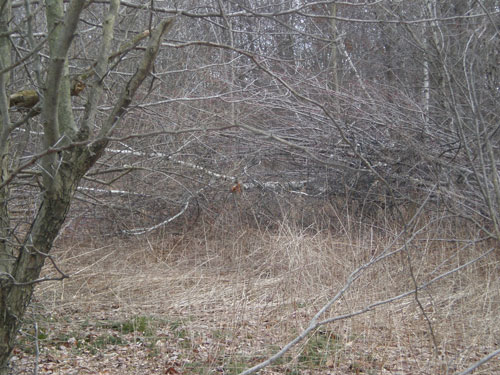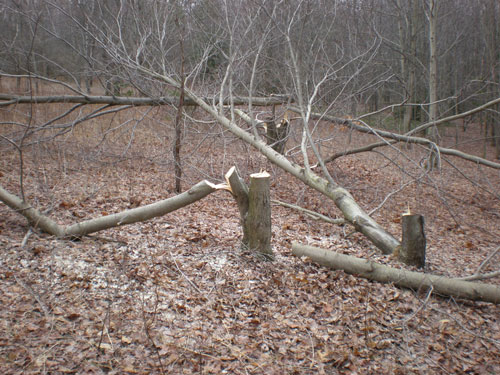 I glassed the area without success but kept my eyes trained on the trails leading from the bedding area. Darkness wouldn’t fall for about two hours. But the squirrel continued to complain and then blue jays squawked in an approaching succession. I stood up.
I glassed the area without success but kept my eyes trained on the trails leading from the bedding area. Darkness wouldn’t fall for about two hours. But the squirrel continued to complain and then blue jays squawked in an approaching succession. I stood up.
I’m an unlucky hunter, the one in camp who sees no deer while everyone else sees dozens. In Montana, I once fell on my bow and broke all my arrows within forty yards of a monster elk. In Alabama, a beautiful 10-pointer I’d arrowed died in a lake, where it was stolen by an alligator.
But here’s a saying I like: “The harder I try, the luckier I get.”
I heard him crunching acorns and then he appeared, in a casual, relaxed, ambling walk down a deer trail towards me. I noted the great brow tines and spread and then coached myself, Stop looking at the antlers. Draw. Holy Cow. Draw now.
I might as well ’fess up — I couldn’t get drawn at first. If you look up “buck fever” in the dictionary, you’ll find my picture there. It was crazy — for some reason I was trying to pull back my bow while holding it a foot from my body. I got hold of myself. And then it was such sweetness, to be at full draw, waiting for him to step into a shooting lane.
In my regular, unlucky hunting life, he would stop with his vitals behind a tree, then snort and run. But on this afternoon a big buck stopped with his kill zone perfectly framed within the wide “V” of a twin-trunked tree. And I even squeezed the trigger instead of slapping it as I usually do. He took off in that scrabbling, slack-tailed run of a hard-hit deer.
He died in a pretty spot, down by the creek.
The actual creation of the bedding area won’t take long, so don’t be adverse to spending lots of time planning. Consider factors such as nearby feeding areas, prevailing wind, terrain, water and existing deer trails. Here’s what you need to think about.
Wind Direction: The prevailing winds in my area are from the northwest. I didn’t want to locate a bedding area if I couldn’t position stands to hunt deer entering and leaving it. If you don’t have an aerial or topographical map of your area, a hand-drawn one will do for planning.
Feeding Areas, Water: Ideally, a bedding area should be located between feeding areas and have a water source. If you don’t have a water source, you can try to make one nearby. On my farm I also train pointing dogs, and have a couple dunk-a-dog-sized water troughs. To my surprise, the dog and human odors didn’t keep the deer from using the troughs to get water.
Terrain, Trees & Brush: Maples are the best trees for hinge cutting, because the tree will remain alive and send tasty shoots up vertically from the horizontal trunk. I learned the hard way that in order to properly hinge-cut trees, you must cut at an angle. If you cut the trees straight across, you’ll end up either cutting right through, or you won’t be able to bend the tree over to the ground.
 With the bigger trees, say, so big you can’t fit two hands around them, you’re better off just cutting the tree to a low stump, which will sprout. Hinge-cutting seems to work best on the smaller-diameter trees.
With the bigger trees, say, so big you can’t fit two hands around them, you’re better off just cutting the tree to a low stump, which will sprout. Hinge-cutting seems to work best on the smaller-diameter trees.
The best time to cut trees is during the winter months, with the added bonus of creating forage for deer by putting the tree tops within their reach. My bedding area had a number of sassafras trees, which the deer loved, judging by their tracks in the snow.
Create structure while dropping trees, but be careful not to create “traps.” Deer need to feel that they have an escape route.
Deer Trails: I enjoy steering deer. There were several exit trails leaving the bedding area and heading towards a field on a neighboring property that is alternately planted in soybeans and corn. But there were no good stand trees to cover those trails — so I rerouted the trails. While making the bedding area, I made a 70-yard brush row across the bottom of the bedding area, blocking off two of the trails. Now the deer can only use the trails which take them by a couple good stand trees. This type of work is best done in the winter months, because it does take the deer a while to adjust to the changes.
A few days later, I sipped coffee on the front deck, watching for my friend Bo Rogers to arrive. He wanted to hunt the farm, and I’d gotten up so I could walk him to a new stand.
Wait, what was that in the moonlight? Like an amoeba, shape-changing, a deer morphed across the grass of my front yard. I grabbed my new binocular. Holy cow. It was a twelve-pointer, much bigger than the buck I’d arrowed. He angled away towards the bedding area.
Sweet dreams, I thought to myself. Sweet dreams.






